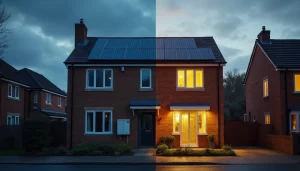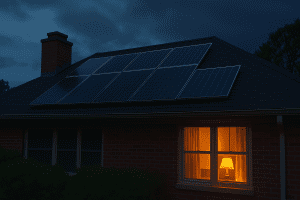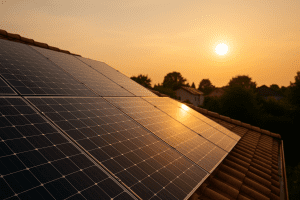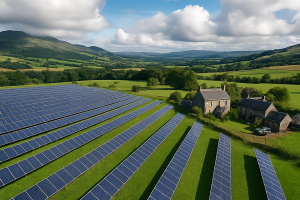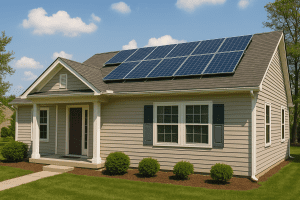Solar Panels During Power Cuts: What UK Homeowners Need to Know
Written By
- Alex Rohn
Published on
- 12 Jun 2025
Power cuts affect about 66% of UK households, and they usually last two and a half hours. Many homeowners with solar panels ask if their systems work during these outages. The answer isn’t simple. Standard grid-tied solar panel systems shut down automatically when power goes out. This keeps engineers safe by stopping electricity from flowing back to the grid while they fix the problem.
The good news is that your solar energy system can power your home during blackouts if you set it up right. You’ll need solar battery backup systems that come with “islanding” capability. This lets your panels generate power on their own, separate from the grid. UK homes can use a special relay switch that cuts off the system when the grid fails. A fully charged 10kWh system with solar panels and battery backup can run your basic home appliances for 12-24 hours based on how much electricity you use. Your battery backup can keep charging from the panels during the day if you set it up correctly. This piece shows you how to use solar panels during UK power outages and keep your essential devices running when you most need them.
Why Solar Panels Shut Down During Power Cuts
Many UK solar panel owners get surprised when they learn their solar systems automatically disconnect from the grid during power cuts. This isn’t a design flaw but a vital safety feature built into all grid-tied solar systems. Let’s get into why this happens and the technology behind it.
Inverter Auto-Shutdown for Grid Safety
Your solar panel system has a grid-tied inverter that watches the electricity grid’s condition. These smart devices can spot problems in grid voltage and frequency within split seconds. Your inverter shuts down right away when it spots a grid outage.
The biggest reason for this auto-shutdown is keeping utility workers safe. Think about electricity engineers climbing power poles to fix lines after storms or accidents. Your solar panels would keep sending electricity back into what workers think are “dead” lines without this shutdown. This creates a dangerous situation where lines they assume are safe could carry deadly current.
It also keeps the grid infrastructure safe. Grid equipment turns off when it finds major problems. Your solar system could damage expensive transformers and other equipment if it kept feeding power back during an outage.
Anti-Islanding Protection Explained
“Islanding” happens when part of the grid gets isolated but still receives power from distributed generation sources like solar panels. This creates an “island” of electricity in a dead grid. Anti-islanding protection stops this from happening.
Every grid-tied solar inverter in the UK must have anti-islanding features that:
Watch grid voltage and frequency settings
Spot when grid power fails or becomes unstable
Cut off your solar system from the grid in milliseconds
Stop electricity from flowing back into utility lines
This protection system makes sure your solar panels can’t create a dangerous electrical island that risks worker safety or damages equipment. Today’s inverters spot grid failures almost instantly, which makes them very reliable safety devices.
Legal and Safety Regulations in the UK
Anti-islanding protection isn’t optional in the UK—it’s required by law. Royal Decree regulations set specific rules for inverter operation, including voltage ranges, operating frequencies, and efficiency levels. These rules also specify when automatic disconnection must happen.
UK inverters must shut down within these timeframes based on grid conditions:
Severe overvoltage (15% above normal): 0.2 seconds max
Standard overvoltage (10% above normal): 1.5 seconds max
Undervoltage (15% below normal): 1.5 seconds max
Frequency problems: 0.5-3 seconds depending on how bad they are
These strict requirements keep safety standards consistent across all solar installations. Trying to bypass these protections breaks the law and creates serious liability issues. Anyone who tampers with anti-islanding protection faces heavy penalties.
This automatic shutdown might seem like a hassle during power cuts, but it’s smart safety engineering rather than a limitation. You can find other solutions to keep power flowing while staying safe and following regulations—we’ll look at those next.
How to Keep Solar Panels Working During Outages
Solar panels can keep generating electricity during grid outages in several ways. You can maintain power even when your neighbors lose it. The right equipment and proper planning will make this possible.
Off-Grid Systems vs Grid-Tied Systems
Most UK homes use grid-tied solar systems as their standard choice. These systems let you export excess electricity to the national grid and import power when needed. These systems shut down automatically during power cuts to ensure safety.
Off-grid solar systems work without any connection to the utility grid. Solar panels, inverters, and battery storage generate and store all the energy your home needs. These setups keep working during power cuts because they never connect to the grid.
A true off-grid system costs too much for most UK homeowners. The good news is that you can get the best of both worlds – grid reliability combined with off-grid independence.
Battery Backup with Emergency Power Supply (EPS)
Emergency Power Supply (EPS) lets your solar system switch to battery storage power during outages. This happens either automatically or manually. Many people think a standard solar panel and battery system will provide backup power during outages. This isn’t true without specific EPS functionality.
EPS systems come with different levels of functionality:
Automatic Socket Backup: A dedicated double 13A socket connects to your battery system and activates quickly during power cuts
Automatic Circuit Backup: Powers specific circuits through an additional consumer unit
Manual Whole House Backup: Lets you switch to battery power after turning off high-power appliances
Automatic Whole House Backup: Your entire home switches to battery power without interruption
Your needs and budget will determine which level works best. Most modern hybrid solar inverters support EPS compatibility. Yet all but one of these systems need external components to work.
Relay Switches and Islanding Functionality
Controlled islanding makes solar power possible during outages. A relay switch creates a safe “energy island” in your home by disconnecting from the grid during power cuts. Some people call this a transfer switch.
This controlled islanding keeps your solar electricity powering your home safely. It prevents power from reaching the grid where it could harm utility workers. The relay sits between your main fuse board and incoming electricity supply. This creates a safe switch from grid power to your battery system.
Only top inverter brands let you use stored energy and generate new solar energy during power cuts. Other systems limit you to the energy stored in your batteries when the outage starts.
Note that EPS functionality adds extra cost to your system. You should ask your installer about this before installation. The price and complexity depend on how much of your home needs power during outages.
Choosing the Right Battery Backup System
Your choice of battery backup system needs you to think about your energy requirements and system parts. The right setup will give your solar panels the ability to work well during power cuts.
Battery Inverter Size vs Solar Inverter
Your battery inverter should match your solar system to get the best performance. Modern hybrid inverters work as both solar and battery inverters, so you don’t need separate devices. Your inverter’s capacity should be about 75% of your solar panel system’s kilowatt-peak (kWp) rating. To cite an instance, a 5kW solar array works best with a 3.7kW inverter.
Your solar array can be larger than your inverter capacity (up to 130%), which helps especially during UK winter months when solar production drops. Notwithstanding that, too much oversizing results in “clipping,” which wastes extra power and strains your equipment.
Your battery system should blend with your existing or planned solar setup. Some systems need compatible inverters from the same manufacturer, while others are more flexible.
Essential Loads vs Whole Home Backup
You’ll need to choose between powering your entire home or just essential circuits during an outage:
Essential Loads Backup: Powers critical appliances like refrigerators, lights, WiFi routers, and small devices. You’ll need one hybrid inverter and a smaller battery (typically 5-13kWh). This option costs less and runs longer during outages.
Whole Home Backup: Powers your entire property including high-consumption appliances. You’ll need multiple inverters stacked together and larger battery capacity (15-30kWh). This costs nowhere near as much but gives complete comfort during outages.
UK homeowners usually choose essential loads backup because it’s budget-friendly and meets practical needs. This approach keeps critical services running at reasonable system costs.
Battery Backup for Home Power Outage UK
Your battery capacity should match your daily energy use to work well during UK power cuts. A household using 8kWh daily needs at least 8kWh battery capacity to keep essential services running for one day.
Battery depth of discharge (DoD) affects overall system performance. Modern lithium-ion batteries offer 90-95% DoD, which means you can use almost all stored energy without damaging the battery.
UK homes that face frequent outages should look at systems with expandable capacity. Some manufacturers offer modular solutions that let you add batteries as your needs change. Professional installation with proper safety measures is vital, particularly regarding UK-specific earthing requirements.
Performance During Extended Power Cuts
Your solar battery system’s performance during extended power cuts beyond a few hours is vital to keep essential home functions running. A well-planned solar setup helps vital appliances work throughout lengthy outages.
How Long Can a 10kWh Battery Last?
A standard 10kWh solar battery powers an average household for about 10-12 hours during blackouts. This estimate assumes you use between 750W to 1000W of electricity just for essential loads. Smart energy management might add an extra hour or two of runtime.
Here’s what you can power:
A medium radiator running 4 hours: 4800W
Three LED lights for 12 hours: 396W
A refrigerator for 24 hours: 1632W
A large TV for 3 hours: 300W
Phone charging and miscellaneous: 500W
These loads add up to roughly 7600W, which leaves room for more essential devices in a 10kWh system.
Impact of Cloudy Days and Winter Months
Solar panel performance drops during cloudy weather and winter months. Overcast days reduce your panels’ output to 10-25% of their normal capacity. This lower generation affects how fast your battery recharges during long outages.
Winter brings more challenges and cuts solar generation to about half of summer production. Your battery might not fully recharge each day during winter power cuts because of shorter daylight hours and more cloud cover.
Modern solar panels still capture scattered light in cloudy conditions and generate valuable power. Rain can help clean dust off panels and improve their efficiency afterward.
Load Management for Extended Runtime
Long outages require smart load management. Your system runs longer if you focus on powering critical appliances first. You need to cut unnecessary power usage while keeping essential functions running.
Poor load management could overload your inverter and shut down the whole system. Here’s what you can do:
Program your system to focus on essential circuits
Skip power-hungry appliances like vacuums and washing machines
Use time-of-use settings to maximize battery discharge
Track your power use through smartphone apps if available
Smart load management helps your battery work better and powers your home longer with fewer batteries. This becomes especially important during extended outages that limit recharging options.
Installation and Cost Considerations for UK Homes
Solar panels need more than just batteries to work during power cuts – proper installation plays a crucial role. You need to understand the required components and work with qualified professionals to make a real difference.
Do You Need a UPS or Manual Switch?
Your specific needs will determine the choice between a UPS (Uninterruptible Power Supply) and a manual switch. UPS systems draw backup power straight from batteries, while manual switches need someone to activate backup power during outages. Solar battery installations typically come with four main setup options:
Direct socket connection to EPS output (simplest but requires manual plugging in)
Dedicated EPS consumer unit powering essential circuits only
Full property backup with manual changeover switch (prevents accidental overloads)
Automatic whole-house backup (most convenient but risks overloading)
Working with electricity comes with inherent dangers. National electrical codes require transfer switches that meet strict safety standards, which only professionals can implement reliably.
Installation Costs for EPS-Enabled Systems
The cost of adding EPS functionality goes beyond the battery price. A standard battery system costs between £4,000 and £6,000. Installation adds £500-£2,000 based on complexity. You can save £2,000-£3,000 by installing batteries along with solar panels.
EPS functionality requires additional components like automatic or manual relays, consumer units, and sometimes new sockets or earthing networks. These additions increase installation costs. Many installers suggest evaluating if you really need EPS, since UK households face only 0.4 power outages yearly, lasting about 35 minutes total.
Working with MCS-Certified Installers
MCS certification shows installer competence and product quality in the renewable technology sector. MCS-certified installers provide these benefits:
Access to qualified professionals who follow industry standards
Quality assurance for both installation and products
Eligibility for Smart Export Guarantee (SEG) payments
Easy finding through the MCS database of approved installers
MCS stands as the only scheme that proves competence in renewable installations, making sure your solar battery system meets all safety and performance standards.
Making use of your solar system during power outages needs careful planning and the right equipment. The UK grid keeps modernizing, yet adding backup capability to your solar setup will give you peace of mind and energy security when unexpected outages happen.
Keeping power during grid failures is one of the most valuable features of modern solar systems. Your home can stay powered while other properties go dark if you design your system properly. Here’s what you need to focus on:
Start by telling your installer exactly what backup power you need before you buy a system. Many homeowners find out too late that their standard solar battery setup can’t provide emergency power. You should ask exactly what happens during a power cut and how the system switches between grid and battery power.
Next, figure out which appliances you really need during outages. Most UK homes do well with a targeted approach that powers refrigeration, lights, communication devices, and medical equipment if needed. This focused strategy costs nowhere near as much as whole-house backup and gives you longer runtime from smaller battery systems.
You should also think about future-proofing your installation. The best systems let you add more batteries as your needs change. This modular approach helps balance your current budget with long-term energy independence goals.
Your backup capability will change with seasons. Winter months give you 50-75% less solar generation than summer, so your backup runtime changes throughout the year.
Note that backup power from solar gives you valuable protection against unpredictable weather patterns that affect grid stability. Think of this capability as an investment in your household’s resilience rather than just an emergency measure.
To get the best results, ask for system demonstrations during installation and test how your backup functions work under simulated grid failures. This hands-on check will make sure your system works exactly as expected when you need it most.
FAQs
Q1. Do solar panels work during power cuts in the UK? Standard grid-tied solar panels automatically shut down during power cuts for safety reasons. However, with the right setup, such as a battery backup system with Emergency Power Supply (EPS) functionality, solar panels can continue to provide electricity during outages.
Q2. How long can a solar battery power a home during an outage? A typical 10kWh solar battery can power essential household appliances for about 10-12 hours during a power cut. This duration can be extended with careful energy management and prioritization of critical loads.
Q3. What’s the difference between essential loads backup and whole home backup? Essential loads backup powers only critical appliances like refrigerators, lights, and small devices, typically using a smaller battery (5-13kWh). Whole home backup powers the entire property, including high-consumption appliances, requiring larger battery capacity (15-30kWh) and multiple inverters.
Q4. How does weather affect solar panel performance during power cuts? Cloudy weather and winter months can significantly reduce solar panel output. On overcast days, panels may produce only 10-25% of their normal output, while winter production can drop to about 50% of summer levels. This affects how quickly batteries recharge during extended outages.
Q5. What should I consider when installing a solar battery system with backup capability? Key considerations include choosing between a UPS or manual switch, working with MCS-certified installers, and understanding the additional costs for EPS-enabled systems. It’s also important to clearly communicate your backup power requirements to your installer and consider future expansion possibilities.

